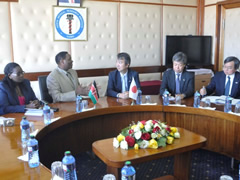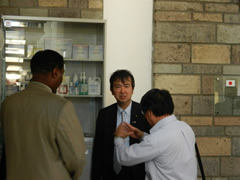- Home
- Technical Cooperation Projects
- Index of Countries
- Africa
- Kenya
- The Project for Development of Rapid Diagnostics and the Establishment of an Alert System for Outbreaks of Yellow Fever and Rift Valley Fever in Kenya
- Project News
- Vice-Minister for Foreign Affairs Hon. Ishihara’s visit to KEMRI Headquarters
Project News
2014-03-07
Vice-Minister for Foreign Affairs Hon. Ishihara’s visit to KEMRI Headquarters
Japanese Vice-Minister for Foreign Affairs Hon. Hirotaka Ishihara visited KEMRI Headquarters on Friday, March 7, 2014. Dr. Mpoke (KEMRI's Director), Ms. Boit (KEMRI's Deputy Director), and 9 center directors and senior staff members from KEMRI welcomed Hon. Ishihara.
Dr. Mpoke presented the history and overview of KEMRI. He highlighted the longstanding assistance KEMRI has received from Japan, which dates back to 1979, especially in the area of communicable diseases research. Currently, a joint research project is carried out on yellow fever and Rift Valley fever (JICA-JST SATREPS project). Through these collaborations between Japan and KEMRI, many researchers have been trained in Japan, equipment and machineries were donated to the KEMRI research centers, and excellent researchers were trained through technical partnership programs in Kenya. Hon. Ishihara was happy to hear that many researchers who received training in Japan are currently working at KEMRI, and he was happy to visit this research institution that has longstanding partnerships with Japan.
Hon. Ishihara visited the Production Department at KEMRI and the P3 laboratory[1] within the virology research block, which was built through Japanese grant assistance. Hon. Ishihara, KEMRI centre directors, and SATREPS project members discussed and exchanged ideas on topics such as current status of communicable diseases in Africa and the market scale of yellow fever point of care test kits, which is now under development through the SATREPS project. Hon. Ishihara seemed very interested in the activities at KEMRI and the SATREPS project.


Note
- [1] P3 laboratory: It is a laboratory facility that deals with Biosafety level (BSL) 3 agents (various bacteria, parasites, and viruses that can cause severe to fatal diseases, including HIV and other hemorrhagic fever viruses such as yellow fever virus, Rift Valley fever virus) in a safe environment with tight regulation and management system such as physical containment equipment that includes negative pressure and sealed penetrations that will avoid agents from escaping outside the laboratory. P3 refers to physical containment levels (Physical containment level 3). Level 4 is the highest level. Biosafety level refers to the level of containment precautions required to handle agents in an enclosed facility. In order to deal with BSL 3 agents, P3 laboratory facilities are required. BSL 3 also refers to the level of enclosure of a laboratory.
- About JICA
- News & Features
- Countries & Regions
- Our Work
- Thematic Issues
- Types of Assistance
- Partnerships with Other Development Partners
- Climate Change / Environmental and Social Considerations
- Evaluations
- Compliance and Anti-corruption
- Science and Technology Cooperation on Global Issues
- Research
- JICA Development Studies Program / JICA Chair
- Support for the Acceptance of Foreign HRs / Multicultural and Inclusive Community
- Publications
- Investor Relations
